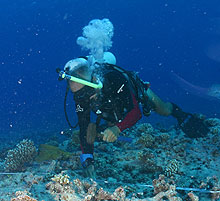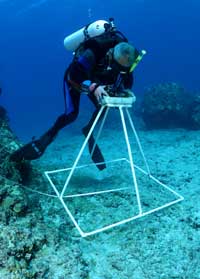NOWRAMP
2002
U.S.
FISH & WILDLIFE SERVICE CORAL REEF MONITORING PROGRAM
IN THE NORTHWESTERN HAWAIIAN ISLANDS (NWHI)
Posted by Jim Maragos, Ph.D., Coral Reef Biologist
Pacific/Remote Islands National Wildlife Refuge Complex,
US Fish & Wildlife Service
Photography by Jim Watt
 The
U.S. Fish & Wildlife manages 10 National Wildlife Refuges
(NWR) in the Pacific that protect coral reefs, and the Hawaiian
Islands NWR and Midway NWR extend protection to 9 of the
10 areas of the NWHI. Long-term monitoring is an essential
responsibility at all NWR and to date 70 permanent monitoring
sites on coral reefs have been established at 9 of the Pacific
NWR including 36 in the NWHI since 2000. The 2002 NOWRAMP
Rapture expedition alone supported installation of
19 new monitoring sites and resurvey of 6 existing sites
in the NWHI. An additional 5 sites at French Frigate Shoals
will be resurveyed by the end of October 2002. Many of the
earlier permanent transect surveys were facilitated by the
Honolulu Laboratory of the National Marine Fisheries Service
(NMFS) and their research vessel, the R/V Townsend Cromwell.
The
U.S. Fish & Wildlife manages 10 National Wildlife Refuges
(NWR) in the Pacific that protect coral reefs, and the Hawaiian
Islands NWR and Midway NWR extend protection to 9 of the
10 areas of the NWHI. Long-term monitoring is an essential
responsibility at all NWR and to date 70 permanent monitoring
sites on coral reefs have been established at 9 of the Pacific
NWR including 36 in the NWHI since 2000. The 2002 NOWRAMP
Rapture expedition alone supported installation of
19 new monitoring sites and resurvey of 6 existing sites
in the NWHI. An additional 5 sites at French Frigate Shoals
will be resurveyed by the end of October 2002. Many of the
earlier permanent transect surveys were facilitated by the
Honolulu Laboratory of the National Marine Fisheries Service
(NMFS) and their research vessel, the R/V Townsend Cromwell.
 Before
the 2002 expedition, the USFWS established 2 monitoring
sites at Midway
in 2000 to monitor the effects of eco-tourism, 4 at Pearl
and Hermes in 2000 to assess the damages of a grounded
fishing vessel, 2 to monitor corals at NOAA Coral Reef Early
Warning System Buoys (CREWS) at French
Frigate Shoals (FFS) and Maro
Reef in 2001, and 9 additional sites at FFS to monitor
the effects of seawall repair near Tern Island and natural
stresses at several pristine sites. The 2002 expedition
allowed 1 to 4 new permanent monitoring transects to be
established at 9 of the 10 NWHI except Kure
Atoll, a State of Hawai‘i Reserve. All of these
were placed at a variety of pristine habitats to monitor
changes attributed to natural stresses and effects, and
included surveys at 3 CREWS buoy sites (FFS, Midway Atoll
and Laysan
Island).
Before
the 2002 expedition, the USFWS established 2 monitoring
sites at Midway
in 2000 to monitor the effects of eco-tourism, 4 at Pearl
and Hermes in 2000 to assess the damages of a grounded
fishing vessel, 2 to monitor corals at NOAA Coral Reef Early
Warning System Buoys (CREWS) at French
Frigate Shoals (FFS) and Maro
Reef in 2001, and 9 additional sites at FFS to monitor
the effects of seawall repair near Tern Island and natural
stresses at several pristine sites. The 2002 expedition
allowed 1 to 4 new permanent monitoring transects to be
established at 9 of the 10 NWHI except Kure
Atoll, a State of Hawai‘i Reserve. All of these
were placed at a variety of pristine habitats to monitor
changes attributed to natural stresses and effects, and
included surveys at 3 CREWS buoy sites (FFS, Midway Atoll
and Laysan
Island).
Each
monitoring site involves installing stainless steel stakes
in the reef at 5m intervals along a 50m transect. The stakes
are hammered into the reef away from corals and epoxy is
applied to better secure the stakes. A graduated surveyor
tape is then laid along the transect over the stakes, and
the entire transect is photographed and many also videotaped
along a meter-wide swath along the transect. High-resolution
Nikon RS cameras are mounted on a one-square meter quadrat
frame, and the entire line is photographed, one square meter
at a time. After photography, the lines are removed, but
the stakes remain to help investigators find and resurvey
each line in future annual visits. This approach allows
precise resurvey of the same reef tracts over time to monitor
changes, even those of individual coral colonies.
 In
light of the recent occurrence of mass coral bleaching at
Pearl and Hermes, Midway, and Kure at the northern end of
the NWHI, the role of long term monitoring takes on greater
significance in this largest protected pristine coral reef
ecosystem in the Pacific. Although 36 permanent monitoring
sites seems like a good start, many more sites need to be
installed in the huge 9,000 sq. km reef area of the NWHI.
Priority attention will be given to analysis of the results
of all monitoring data for the NWHI in the next several
months.
In
light of the recent occurrence of mass coral bleaching at
Pearl and Hermes, Midway, and Kure at the northern end of
the NWHI, the role of long term monitoring takes on greater
significance in this largest protected pristine coral reef
ecosystem in the Pacific. Although 36 permanent monitoring
sites seems like a good start, many more sites need to be
installed in the huge 9,000 sq. km reef area of the NWHI.
Priority attention will be given to analysis of the results
of all monitoring data for the NWHI in the next several
months.
I'd
like to acknowledge the assistance and support of several
key people in this endeavor: Daria Siciliano (UC Santa Cruz),
Rusty Brainard (NMFS), Marjo Vierros (UC Santa Cruz), Yuko
Stender (Rapture Marine Expeditions), and Ranya Henson (Humboldt
State University).
<<back